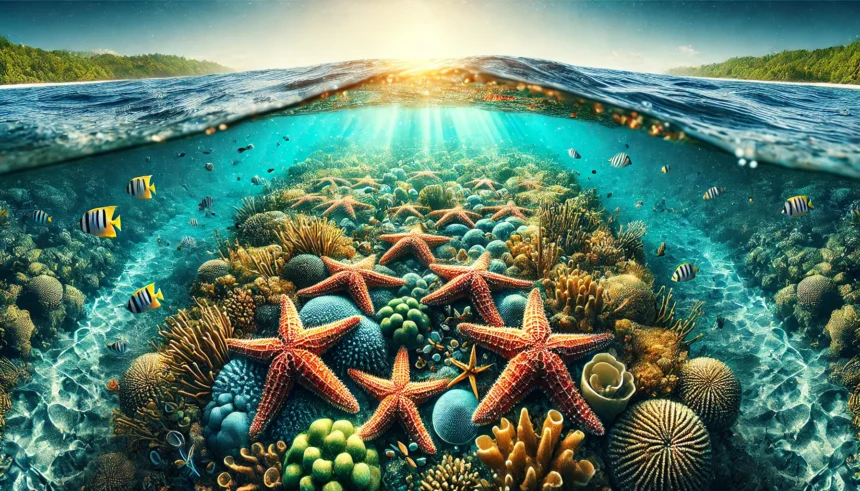Starfish, also known as sea stars, are captivating marine creatures that inhabit oceans across the globe. Their unique appearance and ecological importance make them a fascinating subject for marine enthusiasts. Understanding the environmental parameters of starfish is crucial for their conservation and the health of marine ecosystems. Let’s explore these parameters in detail.
Natural Habitat of Starfish
The environmental parameters of starfish start with their diverse habitats. Starfish thrive in various marine environments, from shallow tide pools to the ocean’s deepest depths. They are often found on coral reefs, sandy shores, rocky seabeds, and seagrass meadows. These habitats provide them with abundant food sources and shelter from predators. Whether basking in tropical waters or surviving the freezing depths of polar regions, starfish have adapted to diverse conditions.
Temperature Preferences
One of the critical environmental parameters of starfish is temperature. Most species flourish in water temperatures between 0°C and 30°C. Polar starfish can survive near-freezing conditions, while tropical species are accustomed to warm, sunlit waters. Their ability to adapt to temperature variations is a testament to their resilience.
Salinity and Water Conditions
Starfish are exclusively marine animals and require saltwater to survive. Among the essential environmental parameters of starfish, salinity plays a significant role. They thrive in salinity levels between 30-35 parts per thousand (ppt). Freshwater exposure disrupts their internal balance, often leading to fatal consequences. Maintaining proper salinity in their habitat is essential for their survival and reproduction.
Oxygen and Water Flow
Starfish respire through tiny structures called papulae and tube feet, which extract oxygen directly from the water. Adequate oxygen levels and water flow are vital environmental parameters of starfish that ensure their health. They rely on moderate water flow to provide a steady oxygen supply and aid in waste removal. Environments with poor oxygen levels or stagnant water can severely impact their health.
Light Sensitivity
Another intriguing environmental parameter of starfish is their sensitivity to light. Starfish are generally more active in low-light conditions. Their eye spots, located at the tips of their arms, allow them to detect light and navigate their surroundings. This sensitivity helps them find food and avoid predators, making them nocturnal hunters in many regions.
Effects of Ocean pH and Pollution
The environmental parameters of starfish are closely tied to the health of their oceanic environment. Ocean acidification, caused by rising CO₂ levels, poses a significant threat to starfish. Acidic conditions weaken their calcified skeletons, making them more vulnerable to environmental stressors. Additionally, pollutants such as plastics, heavy metals, and oil spills disrupt their physiological processes and can even be fatal. Protecting our oceans is vital for their survival.
Nutritional Requirements
Starfish are opportunistic feeders, with diets that include mollusks, algae, and organic debris. Their diet is an essential environmental parameter of starfish that impacts their population health. They play a crucial role in the marine food chain by controlling the population of prey species, such as clams and mussels. A balanced ecosystem ensures the availability of food, directly impacting starfish populations.
Predators and Ecosystem Role
Despite their tough exterior, starfish are preyed upon by crabs, fish, and sea birds. Understanding their role as both predators and prey highlights the environmental parameters of starfish that contribute to a balanced ecosystem. Their presence indicates a healthy marine environment and supports the overall biodiversity of the ocean.
Conservation Importance
By studying the environmental parameters of starfish, scientists and conservationists can better protect these fascinating creatures. Protecting their habitats, reducing ocean pollution, and combating climate change are crucial steps to ensure their survival. By safeguarding starfish, we also preserve the delicate balance of marine ecosystems.
Conclusion
The environmental parameters of starfish are not just scientific facts—they are a window into the health of our oceans. From their sensitivity to temperature and salinity to their role as predators and prey, every aspect of their environment impacts their survival. Protecting starfish is a shared responsibility that begins with understanding their needs and addressing threats like pollution and climate change.
Frequently Asked Questions (FAQs)
What are the environmental parameters of starfish?
Starfish depend on specific factors like water temperature, salinity, oxygen levels, and ocean pH to survive and thrive.
Can starfish live in freshwater?
No, starfish require saltwater environments with a salinity of 30-35 ppt to maintain their internal balance.
How does pollution affect starfish?
Pollution, such as plastics and heavy metals, disrupts their physiology and weakens their skeletal structure, making survival difficult.
Why is salinity important for starfish?
Salinity is crucial as it maintains the osmotic balance necessary for starfish’s cellular functions and overall health.
What role do starfish play in the marine ecosystem?
Starfish help control prey populations, like clams and mussels, ensuring a balanced and healthy marine ecosystem.
Recommended Article:
Is Bright Digital and Briodigital the Same Company?
Understanding 727-398-3269 Phone Number: Is It a Scam?
Unveiling Influencersginewuld: The Evolution of Influencer Dynamics






